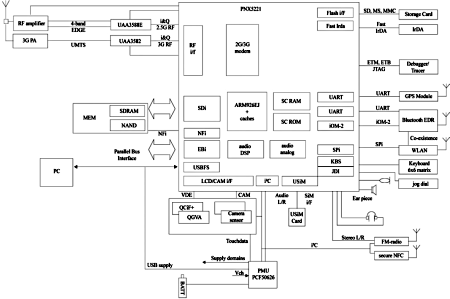Single-core 3G phone design runs Linux on virtualized processor
Feb 9, 2007 — by LinuxDevices Staff — from the LinuxDevices Archive — 20 views VirtualLogix will demonstrate a multimedia-enabled Linux-based mobile phone reference design powered by a single ARM9 processor, at 3GSM next week in Barcelona. The NXP Nexperia 7210 design could spawn some of the world's first single-core mobile phones running open, “rich” operating systems, such as… Linux.
VirtualLogix will demonstrate a multimedia-enabled Linux-based mobile phone reference design powered by a single ARM9 processor, at 3GSM next week in Barcelona. The NXP Nexperia 7210 design could spawn some of the world's first single-core mobile phones running open, “rich” operating systems, such as… Linux.
NXP is a recent spin-off from Dutch consumer electronics giant Philips. It markets chips and reference designs for a variety of consumer electronics products, including handsets, set-top boxes, and other consumer goods.
NXP's Nexperia 7210 mobile phone reference design is based on its PNX5221, a highly integrated SoC (system-on-chip) for GSM/GPRS/EDGE/UMTS mobile handsets. The PNX5221 is powered by a single ARM926EJ processor, along with a pair of 16-bit DSPs that handle image and signal processing. The chip supports Dual Transfer Mode (DTM), for “true UMTS” behavior independent of network type (2.5 or 3G), according to NXP.

NXP Nexperia 7210 reference design diagram
(Click to enlarge)
In addition to the PNX5221 SoC, the Nexperia 7210 phone design appears to integrate cellular and WiFi RF modules, a single bank each of NAND and SDRAM, a power management processor, keypad, jog dial, a memory card interface, and various peripheral modules, such as a camera, FM radio, Bluetooth radio, and GPS.
VirtualLogix says it will demonstrate how NXP's Nexperia 7210 design for Linux leverages virtualization technology to “introduce the rich functionalities of Linux into low-cost feature phones on a 3G handset.” The demo will show an unspecified real-time OS for modem control and a Linux-based application environment — probably based on Qtopia — running simultaneously on the PNX5221's single ARM926 processor core, thanks to VirtualLogix's VLX-MH virtualization product for handsets.
VirtualLogix claims that the single-processor architecture enabled by its technology cuts bill-of-materials costs in half. Additionally, the two OSes are said to run independently of one another, in a fault-tolerant architecture that enables “full operation of core phone services even when the open operating system has been corrupted by mobile malware.” Preserving “minimum phone capabilities” is a key concern for operators, the company notes.
Michel Windal, marketing director of Cellular Systems at NXP Semiconductors, stated, “We are now delivering open operating systems on low-cost, high-volume, feature phones by running the open OS together with the mobile phone stack simultaneously, on shared hardware.”
So far, Linux appears to be the only confirmed rich OS option for the 7210 design. However, VirtualLogix has said in the past that its virtualization technology could be made to work with Windows Mobile or Symbian, and has demonstrated it running with Windows CE on a TI OMAP processor.
VirtualLogix's single-core phone demonstration appears to represent the fruits of a partnership with Philips announced in December of 2005. At that time, the deal represented the first mobile phone customer win for VirtualLogix (formerly “Jaluna”), and co-founder Michel Gien stated, “We are announcing a relationship. Philips has made this selection, and licensed software for use in this project. We hope there'll be product announcements from them shortly. It's a validation of our claim that [OSware] would be useful in phones.”
Motorola's MotoRizr Z6, announced Jan. 8 and apparently destined to be Motorola's first Linux phone for the U.S. market, may also have a single-core architecture, according to reports at MobileBurn.
Also at 3GSM, VirtualLogix will promote its:
- Newly launched VLX-MX virtualization platform demoware for mobile handsets
- VLX-MH, its commercial virtualization technology for handsets, running on the NXP 7210 design
- A single ARM9 processor running Qtopia and its Linux host, together with the radio modem stack (Story) — probably also the NXP 7210 design
- Commitment to mobile handset space through LiPS (Linux Phone Standard) Forum participation
Mark Milligan, VP of marketing at VirtualLogix, stated, “Linux and real-time virtualization enable the consolidation of functionality previously found in multiple devices into a single handset.”
This article was originally published on LinuxDevices.com and has been donated to the open source community by QuinStreet Inc. Please visit LinuxToday.com for up-to-date news and articles about Linux and open source.